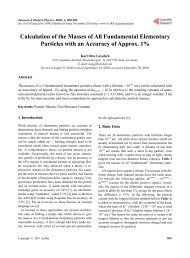Locali crysta ization an als using nd orienta molecula ation of h ar ...
Locali crysta ization an als using nd orienta molecula ation of h ar ...
Locali crysta ization an als using nd orienta molecula ation of h ar ...
You also want an ePaper? Increase the reach of your titles
YUMPU automatically turns print PDFs into web optimized ePapers that Google loves.
1<br />
2<br />
3<br />
4<br />
5<br />
6<br />
7<br />
8<br />
9<br />
10<br />
11<br />
12<br />
13<br />
14<br />
15<br />
16<br />
17<br />
18<br />
19<br />
20<br />
21<br />
22<br />
23<br />
24<br />
25<br />
26<br />
27<br />
28<br />
29<br />
30<br />
31<br />
32<br />
33<br />
34<br />
Acta Crystallographica Section D rese<strong>ar</strong>ch papers<br />
3.4. Multiple occupied states <strong>of</strong> HMT in DR6 <strong>crysta</strong>ls<br />
A closer inspection <strong>of</strong> the obtained MR solutions revealed a local<strong>iz<strong>ation</strong></strong> <strong>of</strong> HMT on a 2-fold<br />
<strong>crysta</strong>llographic symmetry axis (Fig. 4). However, the local 2-fold symmetry axis <strong>of</strong> the HA-cluster<br />
does not coincide with the 2-fold <strong>crysta</strong>llographic symmetry axis <strong>an</strong>d hence breaks the<br />
<strong>crysta</strong>llographic symmetry. Correspo<strong>nd</strong>ingly, the i<strong>nd</strong>ividual tungsten atom positions <strong>of</strong> two symmetry<br />
related HA-cluster molecules showed <strong>an</strong> increasing divergence along the 2-fold <strong>crysta</strong>llographic<br />
symmetry axis. This divergence in-between the symmetry related HA-cluster molecules is coincident<br />
with a blurring <strong>of</strong> the <strong>an</strong>omalous difference density map (Fig. 4B). This co<strong>nd</strong>ition c<strong>an</strong> be interpreted<br />
as two alternative p<strong>ar</strong>tially occupied <strong>orienta</strong>tions <strong>of</strong> HMT inside the <strong>crysta</strong>l. Each <strong>of</strong> the two observed<br />
HA-cluster <strong>orienta</strong>tions forms stronger contacts to one <strong>of</strong> the DR6 molecules <strong>an</strong>d hence belongs to<br />
different asymmetric units. Bi<strong>nd</strong>ing occurs at a positively ch<strong>ar</strong>ged pocket formed by two symmetry<br />
related protein molecules. This te<strong>nd</strong>ency to bi<strong>nd</strong> on special positions, <strong>als</strong>o known from other studies<br />
(e.g. (Ladenstein et al., 1987)), complicates the treatment <strong>of</strong> the HA-cluster during experimental<br />
phase determin<strong>ation</strong>. The multiple occupied state <strong>of</strong> HMT is accomp<strong>an</strong>ied by a low average<br />
occup<strong>an</strong>cy <strong>of</strong> �33% (calculated by occup<strong>an</strong>cy refinement in CNS), reducing the <strong>an</strong>omalous or<br />
isomorphous signal comp<strong>ar</strong>ed to a fully occupied HA-cluster site. As a result <strong>of</strong> this bi<strong>nd</strong>ing state, the<br />
i<strong>nd</strong>ividual tungsten positions were unstable during the positional heavy atom refinement in SHARP.<br />
However, the solutions obtained by MR fit very nicely to the two different HA-cluster bi<strong>nd</strong>ing states.<br />
Consequently, these coordinates could directly be entered for phasing in SHARP without further<br />
positional refinement.<br />
3.5. Applic<strong>ation</strong> <strong>of</strong> MR for substructure determin<strong>ation</strong> in hen egg white lysozyme-TPT <strong>an</strong>d -TaB<br />
derivative <strong>crysta</strong>ls<br />
Encouraged by the successful applic<strong>ation</strong> <strong>of</strong> MR for substructure determin<strong>ation</strong> in DR6-HMT<br />
derivative <strong>crysta</strong>ls, we tested the applicability <strong>of</strong> this approach to a v<strong>ar</strong>iety <strong>of</strong> HA-cluster derivatives.<br />
We first prep<strong>ar</strong>ed <strong>an</strong>d <strong>an</strong>alyzed HA-cluster derivatives <strong>of</strong> the hexagonal <strong>crysta</strong>l form <strong>of</strong> hen egg white<br />
lysozyme (HEWL). This <strong>crysta</strong>l form shows l<strong>ar</strong>ge solvent ch<strong>an</strong>nels, allowing unhi<strong>nd</strong>ered diffusion <strong>of</strong><br />
HA-cluster compou<strong>nd</strong>s inside the <strong>crysta</strong>l (PDB ID: 2FBB; (Brinkm<strong>an</strong>n et al., 2006)). TPT <strong>an</strong>d TaB<br />
were not well soluble in the <strong>crysta</strong>ll<strong>iz<strong>ation</strong></strong> co<strong>nd</strong>ition, requiring <strong>an</strong> optimized soaking procedure (see<br />
Materi<strong>als</strong> <strong>an</strong>d Methods for details). In contrast, the well soluble HMT resulted in rapid degrad<strong>ation</strong> <strong>of</strong><br />
the lysozyme <strong>crysta</strong>ls, probably as a consequence <strong>of</strong> bi<strong>nd</strong>ing <strong>of</strong> HMT to lysozyme <strong>an</strong>d the resulting<br />
destruction <strong>of</strong> <strong>crysta</strong>l contacts.<br />
The two bou<strong>nd</strong> clusters, TPT <strong>an</strong>d TaB, were successfully oriented <strong>an</strong>d localized by MR, cle<strong>ar</strong>ly<br />
i<strong>nd</strong>icated by the scoring values in MOLREP (Table 2). A closer inspection <strong>of</strong> TPT derivative <strong>crysta</strong>ls<br />
revealed a low occup<strong>an</strong>cy <strong>of</strong> the HA-cluster. Occup<strong>an</strong>cy refinement in CNS revealed <strong>an</strong> average<br />
10




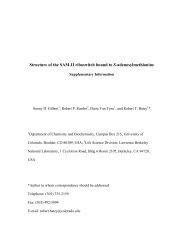

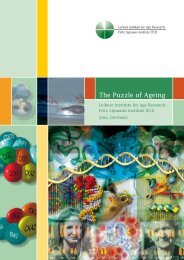

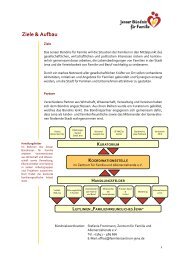



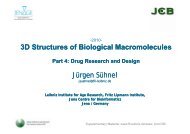
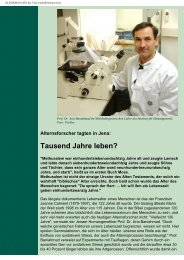

![Programm [pdf]](https://img.yumpu.com/20944039/1/184x260/programm-pdf.jpg?quality=85)
